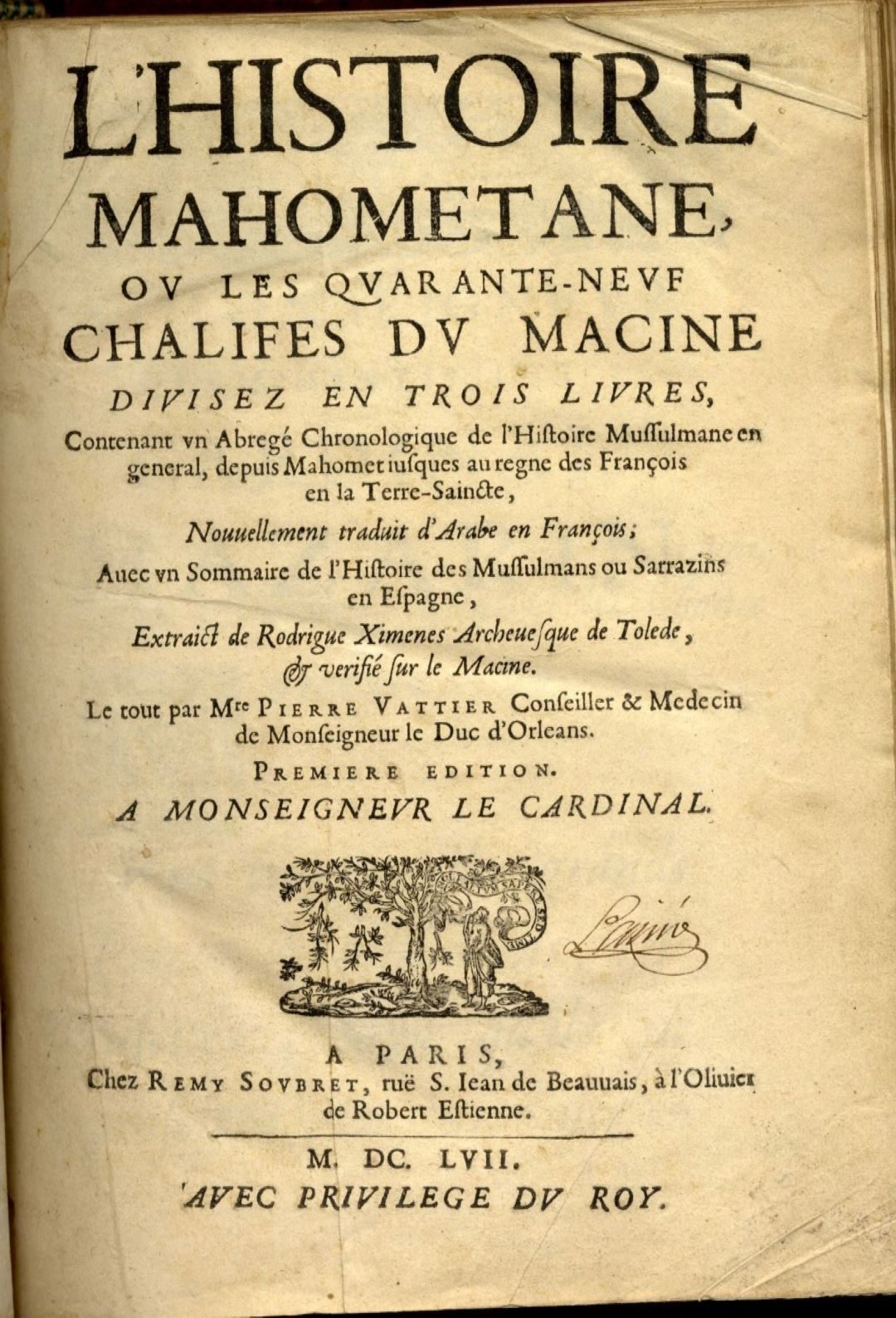L’Histoire Mahométane, ou les Quarante-Neuf Chalifes du Macine. Divisez en trois livres, contenant un abrégé chronologique de l’histoire Mussulmane en général, depuis Mahomet iusques au règne des François en la Terre-Saincte, nouvellement traduit d’Arabe en François; avec un sommaire de l’histoire des Mussulmans ou Sarrazins en Espagne, extraict de Rodrigue Ximines Archevesque de Tolède, et vérifié sur la Macine. THREE PARTS IN ONE.
Makin, Jirjis ibn al-ʻAmid 1205-1273.
Synopsis
The first started with the Creation and covered pre-Islamic times; the second dealt with the Islamic period down to his own times in 1260. For the pre-Islamic period, he used the Bible as a principal source for his history. For the Islamic period, he followed the example of the famous Islamic chronicler al-Tabari. Apparently he used the work of his predecessor Eutychius as well as that of his contemporary Ibn al-Rahib. His chronicle includes a succinct history of the patriarchs of Alexandria (summarised by A. Gutschmidt, 1890, pp. 395-525). It is here that the works of al-Makin and Ibn al-Rahib overlap, and it is difficult to distinguish who copied whom. This work was not hugely original as the author drew from earlier sources, including the world history of Ibn al-Rahib. However, the work was very influential both in the East and West. For example, it was used by the 14th-15th century Muslim historians Ibn Khaldun, al-Qalqashandi, and al-Maqrizi.
The second half was published in Arabic and Latin in Leiden in 1625. The Latin version is a translation by Thomas Erpenius (van Erpen), under the title Historia Saracenica, while a French translation was made by Pierre Vattier as l’Histoire mahomtane (Paris, 1657). An abbreviated English translation was also made from the Latin by Purchas. The translation by Erpenius was one of the first ever made of an Arabic text in modern times, and suffers accordingly from the lack of Lexica and difficulties with the language.
No edition of the whole work exists; there is no critical edition of any part of it, and translations into modern languages are only of trivial portions of the work. This lack is a considerable problem for philology, and renders the text effectively inaccessible to scholarship. Manuscripts of the complete text exist, as well as manuscripts of each half individually. The British Library has the oldest complete manuscript, BL. Or. 7564, from 1280 A.D. The Bodleian Library in Oxford has a manuscript which includes an unpublished Latin translation of the end of the first half of the work and all of the second.
An Ethiopic translation of the whole work also exists, again unpublished, which follows the Arabic closely. It was made during the reign of Lebna Dengal (1508–40). A copy exists in the British Library, shelf mark “Ms. Oriental 814”, comprising 119 folios of the 175-folio book. From this E.Wallis Budge translated the chapter on Alexander the Great, which contains verbatim extracts from the old Arabic Hermetic work al-Istamakhis.
An addition to the Chronicle also exists, written by Al-Muffadal ibn abi Al-Fada`il, who was also a Copt and may have been the author’s great-nephew. It continues the text until the death of al-Malik al-Nasir in 1341. The addition has only limited references to events in the Coptic community, and is mainly a secular history concerned with Muslim affairs. It only survives in a single manuscript, and was apparently written for personal use.
Bibliographic references: I: GAL I, 348; Schnurrer, p. 115, no. 155; Gay 3568; Fück 73; Aboussouan 449 (“1558” in error); OCLC 1811219. II/III: GAL II, 29; Schnurrer, p. 137, no. 167. Fück 82. OCLC 29069177/29069426.








